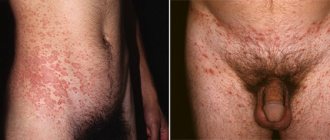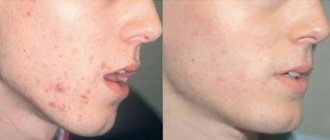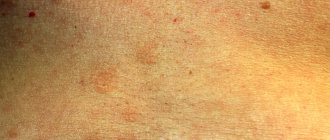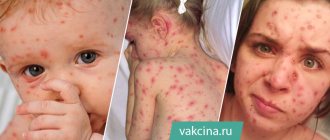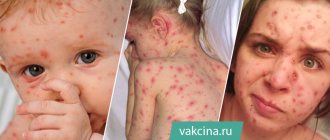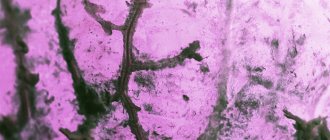Is lichen in cats transmitted to humans? All people who get a new pet (especially a cat from the street) think about this. Ringworm is a highly contagious viral or fungal disease that is spread by spores. You can catch lichen from both domestic and stray animals just by stroking it or picking it up.
What kind of lichen can you get from a cat?
A person can become infected with dermatomycosis - this disease is caused by pathogenic fungi. The most common are trichophytosis, microsporia, and in total about 18 species of fungi that cause this disease have been studied. The second name of the disease is ringworm.
Ringworm
Ringworm is a skin disease caused by pathogenic fungi. The skin and hair are most often affected; sometimes nails and eyelashes are also affected. The fungi that cause the disease are called dermatophytes. The areas of skin on the head that are most affected are the hair becomes brittle and round bald spots form.
The size reaches the size of the palm, the hair appears to be cut off. Because of this feature, the disease got its name. Oval red spots appear on the patient’s body, surrounded by a “crown” of raised skin. The skin in the middle of the lesion flakes and itches.
Here you can see a photo of ringworm and visually assess the extent of skin damage.
Types of lichen
There are different types of feline ringworm:
- Pityriasis rosea is considered quite serious and can be recognized by small pinkish spots located all over the skin. On the skin there is a mother plaque, around which there are small daughter spots. The infected area is itchy and flaky. An interesting fact about pityriasis rosea is that the disease comes spontaneously and also goes away spontaneously.
- The ringworm infects the kitten's skin and moves from one place to another quite quickly. The cat's hair breaks off and has a trimmed appearance, resulting in baldness.
- Pityriasis appears as pink spots that disperse throughout the cat's body.
- The red flat appearance is characterized by the appearance of small blisters filled with fluid. This type becomes a chronic form of the disease and can be found not only on the body, but also in the oral cavity and on the mucous membranes.
How to avoid getting shingles from a cat?
There are many ways to protect yourself from this disease, but the most important thing when communicating with cats, and even with people, is that if there is the slightest suspicion of lichen, immediately stop communicating and take measures to prevent this scourge.
We urgently carry out the following hygiene measures:
- Wash exposed skin areas, mainly the face and hands, thoroughly and more than once with antifungal cleansers. The most affordable is tar soap, which can be purchased in all stores.
- After this, we thoroughly wash the body with this soap or other means, because the infection could spread under the clothes. At the same time, remember that hard washcloths can leave micro-scratches. Therefore, we use soft washcloths.
- There is no time to waste; treatment must be carried out urgently. Antifungal properties are inherent in lavender oil and turpentine. They are used for small treatment areas.
- Wash your hair using antifungal shampoos, you can also use tar and laundry soap.
- See a doctor, but remember that the incubation period for the fungus is 5 days.
Timely treatment will make treatment easier.
Measures when living together with a sick person:
- Linen is washed separately, with preliminary soaking in special products, followed by ironing.
- Wet cleaning is carried out daily, dishes are washed in a disinfectant solution. Cleaning using chlorine-based solutions and others.
- Remove all carpets in the apartment and cover upholstered furniture with film.
- Cover the patient's head with a scarf or cap, wear natural linen and clothing;
- When washing daily, use antifungal shampoos, and to prevent the rash from spreading throughout the body, use Citeal. It is diluted with water 1 to 10. There are reasons why the doctor does not allow the patient to bathe or wet the lichen areas. In these cases, wet wiping is used.
Cat treatment
Treatment of a kitten should only be carried out with the advice of a veterinarian. First of all, the kitten needs to be trimmed bald, because fungal spores are transmitted from a sore spot to a healthy one instantly and sometimes it is impossible to notice a lesion that spreads further. The area affected by the fungus should be treated with iodine or alcohol (10%).
Treatment of a kitten at home should be carried out using antifungal agents. When the lesion has reached a large area of the body, antifungal drugs are used not only externally, but also internally.
If your pet experiences complications, it must be treated with antibiotics and immunostimulants.
Ringworm is recorded in weakened or pregnant cats that have helminths, which are often exposed to stress, and it is also diagnosed in kittens that do not have developed immunity.
Symptoms of the disease
The first symptoms of the disease usually appear in patients on the 5th day, and in other cases - a week after contact with a sick cat. The type of fungus and human immunity have a great influence on the duration of manifestation.
Types of microsporia:
- Smooth skin is affected, areas with hair are not damaged.
- The scalp is affected. The skin feels itchy and a small red spot appears. The border rising along the edge of the spot consists of small pimples. The spot begins to grow and new spots appear. The hair in this area becomes brittle and dull, and then the hair breaks, forming bald spots.
You might be interested! What does pityriasis alba look like on the human body and how to treat it?
You can read more about how to identify lichen here.
Also, forms of lichen are divided into:
- Painful skin color on the unclear boundaries of the lesion is an abortive form;
- Sebaceous inflammation at the site of ringworm and signs of allergy - this is erythematous - edematous;
- The appearance of subcutaneous nodes up to 3 mm, most often appear in women on the legs - this is a deep form;
- Appears on the face and in the chest area, the skin is lumpy, covered with scales - papular-squamous form;
- The lichen areas swell very much, become dense, and pus is released. This is the most severe form - suppurative-infiltrative.
Ringworm in cats is an infectious disease caused by fungi called dermatophytes. In most cases, ringworm affects the skin, but the fur and nails may be damaged. Many types of domestic animals are susceptible to this disease: dogs, cats, rabbits, ferrets, hamsters, rats, guinea pigs. It is important to promptly identify lichen and begin its treatment.
Reasons for the development of lichen
Ringworm in cats is caused by microorganisms: Trichophyton, Microsporum gypseum, Microsporum canis.
Trichophyton provokes the development of a type of lichen called trichophytosis, the remaining two are the culprits of microsporia. Regardless of what causes lichen, its symptoms are identical. Fungi can end up on a cat's fur if it comes from another animal or from the area where they live. Infection occurs when spores enter a moist and warm environment. They can remain on carpets, furniture, and shedding wool for a long time. Ringworm may not appear for up to several months. Most often, kittens are susceptible to deprivation, since their immunity is not yet fully strengthened. Healthy adult animals most often have a natural immunity to ringworm. The risk of infection increases if the cat has free access to the street, if it is infected with parasites, if its nutrition is not adequate. The genetic factor is of great importance; artificially bred breeds do not have innate immunity to this disease.
Main types of lichen
Ringworm is the most dangerous and most common. With ringworm, the cat develops bald patches, and less often it causes itching. Ringworm is most dangerous for long-haired cats, since in the early stages it is difficult to see foci of the disease, which spread gradually. Its first symptoms include round patches of baldness and flakes of white plaque that resemble ash. Most often they occur in the ear area and on the animal’s limbs. It is difficult to identify specific signs as accurately as possible, since the scale of the lesion and its varieties may differ in each case. General clinical symptoms can only indicate the presence of a disease, and the correct diagnosis can only be made by a specialist, based on research and relevant tests. Therefore, you should immediately contact a veterinarian at the first suspicion. Sometimes there are small ulcers, blisters or scales in the affected area. If measures are not taken, the affected area may grow. Moreover, this is not always accompanied by itching. Sometimes lichen can be all over the animal's body. In this case, the skin becomes greasy and peels. It is important to distinguish between ringworm and dermatitis. They have similar symptoms. The owner of the animal needs to remember that the first signs of lichen are excessive shedding and clumping hair. The cat starts scratching his ears too often. If the lichen is localized in the claws, then they become deformed and grow incorrectly.
Pityriasis rosea is a viral infection. Pink spots with a clear outline up to 2 cm in diameter appear on the animal’s skin. Pityriasis rosea is accompanied by itching and flaking of the skin. Most often, after a couple of days, this spot becomes covered with a dry crust. Identical spots may appear on other parts of the animal's body. The appearance of this type of lichen is associated with a sharp decrease in the cat’s immunity, so for treatment it is necessary to maintain and strengthen its immune system. Drug treatment is not necessary. It is worth providing the animal with rest and complete nutrition, which includes all the necessary microelements and vitamins. During this period, it is strictly forbidden to wash the cat. You also need to keep your cat away from direct sunlight. Pityriasis rosea will disappear in 1-2 months.
Pityriasis versicolor is a fungal infection that causes pigment spots to appear on a cat's body. It is highly contagious to humans and animals. This type of lichen develops as a small oval spot that appears on the animal's body; the color can vary from pink to brown. The spots spread throughout the body very quickly and merge into one. Pityriasis versicolor requires medical intervention.
Lichen planus provokes disruptions in the functioning of the immune system. It affects the mucous membranes and skin, and red blisters may appear. During the course of the disease, small spots may merge into one. To identify this type of lichen, it is important to pay attention to the location of the spots. With lichen planus, they appear in the groin and abdomen, on the bends of the joints. This form of lichen is caused by disruptions in the functioning of the immune system.
Ringworm (eczema) is rare. It can be caused by germs or allergies, as well as disruptions in the animal's immune system. Factors that cause an allergic reaction may be a reaction to detergent components or the presence of mites or fleas in a cat. Internal factors include various hormonal imbalances and problems with the nervous system. It's not contagious. The first signs of eczema may be red spots on the skin and increased body temperature in the affected areas. Then bubbles with liquid appear on these spots. With proper treatment, the blisters resolve, but if there is no treatment, the blisters burst and become infected, which can lead to the appearance of ulcers. After the ulcers rupture, the skin on the inflamed area is moisturized. If you treat the disease and provide air to the inflamed area, the eczema will become covered with a crust, which will soon fall off and the skin will be renewed.
Treatment and diagnosis of lichen
The veterinarian makes a diagnosis of an animal suspected of having lichen, which includes:
- External examination of the affected skin areas.
- Examination of the affected hair under a microscope to detect dermatophytes - trichoscopy. It is important that a negative conclusion may not always mean the absence of lichen.
- Examination using a Wood's lamp. The affected area of skin is highlighted in green. But this is not a 100% diagnostic method, since some types of dermatophytosis do not glow.
- Bacterial culture for dermatophytes. For this purpose, environments where these fungi can grow are used. Today this is the most effective research, but you need to wait about 21 days for the results.
- There are also PCR tests for detecting dermatophytosis, but they are not particularly popular yet.
If during the examination it turns out that the animal has lichen, the doctor carries out a set of procedures. Today, if lichen is detected in cats, the following drugs are used for treatment : antifungals (this includes introconozole), which are used orally, as well as special shampoos (such as imaverol, lime sulfur). Treatment lasts up to several weeks until the next diagnostic test results in a negative result.
Vaccines intended to treat different types of lichen are not used because their effectiveness has not been proven in most studies; on the contrary, most of them have many side effects, such as inflammation of the skin at the injection site. Simultaneously with treating the animal, it is worth disinfecting the premises, since dermatophyte spores move through the air.
Prevention of lichen
The first step, of course, is to exclude your pet from contact with other infected animals. But pets can also be at risk of infection if fungal spores get into your apartment. They spread very easily and are quite viable. This is why it is very easy to become infected, and the incubation period is very difficult to control in some cases. If spores persist on cat bedding, upholstered furniture, and carpets, the disease may recur. To avoid re-infection, you need to treat the room with chlorine-containing and other detergents intended for specific items (furniture, fabrics, etc.), and the laundry should be boiled. Please note that other animals can also be carriers of the infection, which does not manifest itself in any way. But at the same time they infect others. This is called an asymptomatic carrier.
For prevention purposes, it is necessary to follow all necessary hygiene procedures for the cat, avoid contact with street animals, and periodically conduct a medical examination with a veterinarian.
If there are several animals in the house, and one of them suffers from shingles, the remaining pets should be immediately examined by a veterinarian, even if the animals appear healthy. Unfortunately, practice suggests that cats who are in the same apartment with a sick animal, in the vast majority of cases, will also be affected by the disease. In order to understand whether other pets became infected from a sick animal, or whether the disease still bypassed them, it is necessary to undergo an examination. If fungal spores are not detected, we recommend bathing healthy animals using a specialized shampoo.
Is ringworm in cats dangerous to human health?
Many pet owners are interested in the question: can lichen be transmitted from cat to person? Of course, if you follow the preventive measures described above, the likelihood of your pet becoming infected with lichen is practically reduced to zero. But forewarned is forearmed, so we tell you what a cat owner should be wary of.
Whether a person gets sick or not depends on the type of lichen. Ringworm cannot be transmitted from animals to humans under any circumstances. But other varieties of this unpleasant disease can also affect the cat’s owner. The thing is that microorganisms and bacteria remain everywhere where the sick animal was. When in contact with human skin, they quickly provoke the occurrence of lichen. Ringworm can occur especially quickly in very young children. This is because their immune system is not yet strong enough. This disease can also appear in people suffering from allergies or chronic diseases.
Like animals, humans also have an incubation period for the disease. In most cases it lasts from 15 to 30 days. Therefore, as soon as you begin to notice the appearance of strange spots on your body, you should immediately visit a dermatologist. The doctor will examine you and prescribe the necessary antifungal medications, as well as medications that can boost your immunity. People, just like cats, need to constantly disinfect and treat affected areas of the skin.
We wish your pet good health, but if he is still affected by any type of lichen, contact our clinics immediately. Our doctors will conduct an examination, diagnose and prescribe the correct treatment.
How to treat feline lichen in humans?
To treat feline lichen in humans, drugs are used that primarily fight the fungus, the cause of the disease. We repeat - the treatment is carried out by a dermatologist and no one else. It is based on the use of both external treatments (creams, sprays and others) and internal ones (antifungal medications).
For treatment the following drugs are used:
- Products for external treatment should contain Mycoseptin, Clotrimazole and other substances. Terbinafine is better suited for treating smooth areas of skin. In the morning, the skin is treated with iodine, and in the evening, sulfur-based ointments (sulfur-tar or salicylic ointments) are prescribed. Vidal's milk and Lassara paste, which are prepared in pharmacies, are often used.
- Systemic treatment uses medications that contain active fungal suppressants. Griseofulvin is often prescribed for internal use. The patient takes it until the fungus disappears in the tests. Analyzes are taken once a week.
- For the treatment of chronic lichen, in addition to antifungal drugs, vitamin therapy is prescribed. It strengthens the walls of blood vessels and improves blood circulation. After recovery, control scrapings are taken - immediately after the end of treatment, after a week and after 2 months. If fungi are detected, other treatment is prescribed.
Also, for treatment, the doctor can prescribe folk remedies that have no less influence on the cure of patients.
Here are just a few of them:
- Propolis tincture. Moisten the sebaceous secretions, repeat 4 times a day.
- Juice from cranberries, which is used to moisten wounds.
- Plantain juice is applied to skin lesions.
- Chamomile decoction is used when washing hair for better healing. This drink has healing properties for growths on the tongue.
- Beet ointment. Add honey to the chopped boiled beets and place in a cool place. Use for application to affected areas of the skin.
Here it must be said that folk remedies are not a panacea, and only in combination with traditional medicine can they be used in treatment.
Prevention
In order not to get cat lichen, you need to know the stages of this disease, external damage to human skin and animal fur. Do not contact with sick animals and people.
Ringworm brings the patient many unpleasant moments, both in terms of well-being and psychologically. But everyone knows that it is better not to get sick at all, and you should always remember the rules of personal hygiene and prevent contact with sick animals and people. Live healthy and happy.
How does infection occur?
Ringworm (dermatophytosis) is an infection caused by microscopically small fungal spores. This infectious disease is caused by the fungus Microsporum canis, similar to molds. Once on the skin of people and animals, the fungal spore germinates like a seed. A substance contained in the top layer of the spore allows it to attach to the skin cell.
After 5 - 6 hours, a germ tube grows from the spore and penetrates the skin layer. Hyphae (threads of the fungus) develop and grow in all directions and deep into the skin layers. They eat the upper skin cells and hair follicles, thereby cutting off the hair. Therefore, this infectious disease is also called “ringworm”. After a week, the mushroom threads are capable of independent reproduction.
You can get lichen without contact with stray animals. The yard where you walk is full of fungal spores and other infectious agents.
Street cats can jump into a child's stroller and leave their infectious scales on benches, sandboxes and children's toys. After a walk, all children's property must be thoroughly disinfected.
The risk of penetration of pathogenic microorganisms increases with abrasions, cracks and hand injuries in close contact with an infected cat, especially when no obvious foci of the disease are visible - sometimes cats are carriers of a fungal infection (the disease does not manifest itself in an active form in them).
Ringworm spreads through shed hairs; the spores are contained in the dandruff and skin flakes the cat combs out. The infection is active for a long time - up to two years. It is important to remember that not only street cats are carriers of this fungal disease; lichen that is transmitted from person to person is especially dangerous.
What to do to avoid getting sick
Prevention measures are simple:
- do not overcool;
- avoid colds;
- take vitamin supplements;
- monitor your diet, which should be nutritious;
- Give your body physical activity: walking, running, fitness, regular gymnastics will help.
Diseases occur against a background of weakened immunity, so pityriasis rosea finds the opportunity to “settle” on the surface of the skin. It seems that the disease is not dangerous, and it is not easy to get infected. But we cannot ignore the fact that Zhiber’s lichen can be confused with another skin disease, and a weakened protective barrier leads to many unpleasant consequences.
What animals are susceptible to this disease?
Absolutely all cats, ferrets, rats, hamsters, dogs, rabbits. Pets that often walk outside, especially on their own, are at greater risk of contracting this highly contagious disease. But domestic cats that come into contact with uninvited guests from the entrance or street can be susceptible to lichen.
Outdoor cats usually become infected from other cats or rodents.
The incubation period lasts up to 4 months. During this period, symptoms of lichen do not yet appear, but the cat is already contagious to humans and other pets. Signs of lichen in cats appear gradually. At first there are small bald patches, then the spots grow, the animal becomes restless, itches, and cannot find a place for itself.
Bald patches and weeping wounds: what are the signs of lichen
Often, cat owners notice small bald patches and flaky areas on their pets’ bodies. This may not always indicate a sign of lichen.
- Often the animal simply does not have enough vitamins, especially in the spring.
- In such a situation, you just need to enrich the diet with the necessary substances, but just in case, take your pet to the veterinarian.
- However, when answering questions about what lichen in cats looks like, experts specifically mention bald patches and flaking.
In addition, this type of microscopic fungus causes severe itching of the skin, gradually covers larger areas of the animal’s body, spreads to the claws, and literally devours the pet. Ringworm is also dangerous for people.
